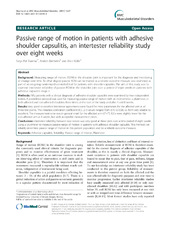| dc.contributor.author | Sharma, Satya P. | en_US |
| dc.contributor.author | Bærheim, Anders | en_US |
| dc.contributor.author | Kvåle, Alice | en_US |
| dc.date.accessioned | 2015-12-28T11:51:49Z | |
| dc.date.available | 2015-12-28T11:51:49Z | |
| dc.date.issued | 2015-02-22 | |
| dc.Published | BMC Musculoskeletal Disorders 2015, 16:37(1) | eng |
| dc.identifier.issn | 1471-2474 | |
| dc.identifier.uri | https://hdl.handle.net/1956/10826 | |
| dc.description.abstract | Background Measuring range of motion (ROM) in the shoulder joint is important for the diagnosis and monitoring of change over time. To what degree passive ROM can be trusted as a reliable outcome measure was examined as part of an on-going randomized controlled trial for patients with shoulder capsulitis. The aim of this study was to examine intertester reliability of passive ROM in the shoulder joint over a period of eight weeks in patients with adhesive capsulitis stage II. Methods Fifty patients with a clinical diagnosis of adhesive shoulder capsulitis were examined by two independent testers. A predefined protocol was used for measuring passive range of motion with an inclinometer, a plurimeter, in both affected and non-affected shoulders three times; at the start of the study and after 4 and 8 weeks. Results Very good to excellent intertester agreements were found for most parameters for the affected arm at all three test points. The intraclass correlation coefficient (ICC 2.1) values ranged from 0.76 to 0.98, i.e. from very reliable to excellent. The measurement error was in general small for the affected arm (5°–7°). ICCs were slightly lower for the non-affected arm at 8 weeks, but with acceptable measurement errors. Conclusions Intertester reliability between two testers was very good at three visits over a time period of eight weeks using a plurimeter to measure passive range of motion in patients with adhesive shoulder capsulitis. This method can reliably determine passive range of motion in this patient population and be a reliable outcome measure. | en_US |
| dc.language.iso | eng | eng |
| dc.publisher | BioMed Central | eng |
| dc.relation.ispartof | <a href="http://hdl.handle.net/1956/17610" target="blank"> Outcome measures and treatment of shoulder capsulitis (frozen shoulder) by corticosteroid injections</a> | |
| dc.rights | Attribution CC BY | eng |
| dc.rights.uri | http://creativecommons.org/licenses/by/4.0 | eng |
| dc.subject | Adhesive capsulitis | eng |
| dc.subject | Reliability | eng |
| dc.title | Passive range of motion in patients with adhesive shoulder capsulitis, an intertester reliability study over eight weeks | en_US |
| dc.type | Peer reviewed | |
| dc.type | Journal article | |
| dc.date.updated | 2015-11-05T10:24:57Z | |
| dc.description.version | publishedVersion | en_US |
| dc.rights.holder | Copyright Sharma et al.; licensee BioMed Central. 2015 | |
| dc.identifier.doi | https://doi.org/10.1186/s12891-015-0495-4 | |
| dc.identifier.cristin | 1253746 | |
| dc.subject.nsi | VDP::Medisinske fag: 700::Klinisk medisinske fag: 750::Fysikalsk medisin og rehabilitering: 764 | |
| dc.subject.nsi | VDP::Midical sciences: 700::Clinical medical sciences: 750::Physical medicine and rehabilitation: 764 | |
| dc.subject.nsi | VDP::Medisinske Fag: 700 | en_US |

